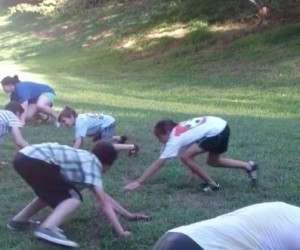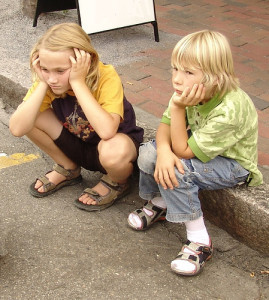I was driving my 9-year-old son to school, and we were reflecting on how the year has been so far when he said something that really surprised me. He said he enjoyed school but had one gripe. He wished he was allowed to play during recess. I was confused when he first said this.
"What do you mean? What do you do during recess then? Don't you play then?" I asked.
When he and his classmates go outside for recess, they are assigned specific activities they are to perform. They are not allowed to change activities, perform variations of the activities, or even to create their own activity with their friends. Some kids are assigned soccer, and they go into a field and play a soccer game, while others are assigned to either kickball, jump ropes (there are only 2), or Frisbee (of which there is only 1).
I have read about other schools banning tag and cartwheels, and I have heard about the slow decline of recess in schools, but this morning it hit me hard. We are doing a disservice to youth. Recess at my son's school has essentially turned into a class he takes. It isn't fun and is viewed by many of the kids as something they HAVE to do -- like work.
Not All Play is Created Equal
The need for increasing and maintaining physical activity in youth is something universally agreed upon, but not all activities are equal. Essentially there are three kinds of activity a child can engage in: unstructured, structured and semi-structured play. Unstructured play can be defined as times when an adult is not structuring the interaction between children. The key here is that the activity is driven by the child and not the adult. The child decides what they play,  how they play and with whom they play.
how they play and with whom they play.
Growing up, this is how recess was for me. The teachers and school aides were present but only in the role of an observer. On the other side of the spectrum there is structured play. This type of play is mostly associated with organized sporting games such as baseball, basketball, football, etc. With structured play, the adults are the ones who regulate the interaction between the children. They dictate the rules, the progression, and pretty much run the show. The third type of play, semi-structured play, is sort of a marriage between the two sides of the play spectrum. This type of play aims to accomplish specific learning goals. This play is often seen in P.E. classes. The teacher will initiate the activity and then the children will lead the rest of the play process. For example, if the goal is for the children to develop throwing and catching skills the teacher might provide different sizes and kinds and instruct the children to play games with them that involve throwing and catching.
What's happening to recess
A common phrase said by many grandparents and parents is that "children of today no longer play the way children used to." In previous generations, during the course of an average school day, an elementary school student would spend 27 percent of his time in school involved in unstructured free play (Hoffman, 1997). The amount of time spent in play was comparable to the amount of time students spent in traditional academic subjects, such as mathematics. Not only that, but how the kids played was also different. Recess was primarily unstructured free play. This was because play was recognized as a crucial part of the student's day. However, the way education and play is viewed has changed since then, and as a result of this, many schools have started to eliminate the free play portion of a child's school day and replace it with more traditional instructional time (Hoffman, 1997). This is done either by replacing free play with more structured play or by eliminating the amount of time dedicated to play all together. To some extent, education has become driven by test scores. American child psychologist David Elkind (2008) stated:
School administrators and teachers -- often backed by goal-orientated politicians and parents -- broadcast the not-so-suitable message that these days play seems superfluous, that at bottom play is for slackers, that if kids must play, they should at least learn something while they are doing it.
As a result, there is simply less playing for the sake of play. This is a huge mistake! Free play offers several unique benefits to child development and decreasing the opportunities a child has to be engaged in free play comes at the expense of these benefits.
Is free play really that important?
YES!
Free, unstructured play is a critical part of childhood. Play is so important to optimal child development that is has been recognized by the United Nations High Commission for Human Rights as a right of every child (Unicef, 1989). The CDC defines recess as "regularly scheduled periods within the elementary school day for unstructured physical activity and play" (CDC, 2000). By participating in free play, children learn to work in groups, share, negotiate and resolve conflicts. When play is child driven, as opposed to being adult led, children are able to learn decision-making skills, to move at their own pace, and independently to discover areas of interest to them (Blasi & Hurwitz, 2002; Pellegrini & Smith, 1998). Free play also helps the children develop their abilities to control their own cognitive and emotional processes, or to "self-regulate" (Vygotsky,1980). This is important because self-regulation is a predictor of a child's academic achievement and their emotional well-being (Whitebread, 2012).
We need to give kids the space to allow the kids to be kids! As mentioned previously, part of these changes come as a result of this push in education for stricter standards and greater academic achievement. Despite the ample evidence
of a whole-child benefit from recess many view recess as wasted time--time that can be better spent on academics. These changes that are taking place during the way recess is offered to our children may actually be counterproductive to academic achievement. Although the changes in recess (mandating what the kids do, when they do it, how they do it, etc.) does at some level promote activity and a healthy lifestyle, free unstructured play offers much more. The participation in unstructured play during recess promotes not only physical health and social development but also improved cognitive and academic performance. It provides students with the opportunity to actually play creatively. The American Academy of Pediatrics policy statement supporting free play as a fundamental component of a child's normal growth and development (Ginsburg, 2007). Replacing unstructured free play during recess with teacher lead structured play where the children aren't allowed to actually play on their own terms, is counterproductive to the growth and development of the child. In addition to this, it may also have unintended consequences in relation to a child's acquisition of important life skills.
Let's let kids be kids again. Just let them play!
This piece was originally published on Joshua's blog, Survival of the Fitness!
- Blasi, M., & Hurwitz, S. C. (2003). For parents particularly: To be successful--let them play! Childhood Education, 79(2), 101-192. doi:10.1080/00094056.2003.10522779
- Centers for Disease Control and Prevention. (2000). Promoting better health for young people through physical activity and sports. Retrieved from http://www2.ed.gov/offices/OSDFS/physedapndc.pdf
- Elkind, D. (2008). The power of play: Learning what comes naturally, American Journal of Play, 1(1), 1-6. Retrieved from Journalofplay.org
- Ginsburg, K. R. (2007). The importance of play in promoting healthy child development and maintaining strong parent-child bonds. Pediatrics, 119(1), 182-191.
- Hoffman, L. E. (1997). The effects of substituting structured play for unstructured play on the attitude of students and teachers (Unpublished doctoral dissertation) University of Lethbridge, Faculty of Education. Retrieved from uleth.ca
- Pellegrini, A. D., & Smith, P. K. (1998). The development of play during childhood: Forms and possible functions. Child Psychology and Psychiatry Review, 3(02), 51-57. doi: 10.1111/1475-3588.00212
- Unicef. (1989). Convention on the rights of the child. Retrieved from http://digitalcommons.ilr.cornell.edu/child/8
- Vygotsky, L. S. (1980). Mind in society: The development of higher psychological processes. Cambridge, MA: Harvard University Press, 92-104
- Whitebread, D. (2012). Developmental psychology and early childhood education: A guide for students and practitioners. Los Angeles, CA: SAGE.
